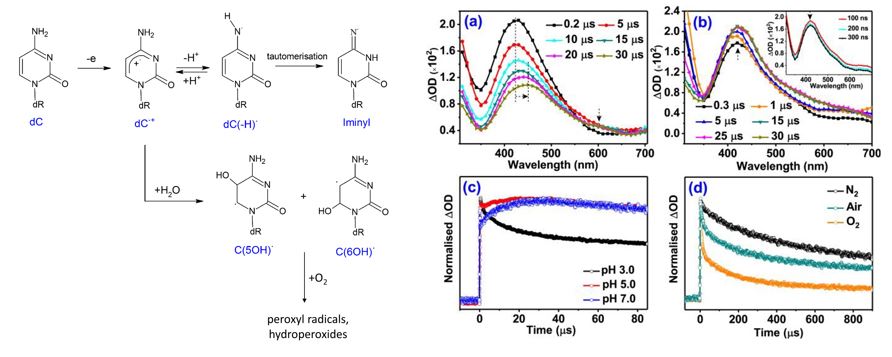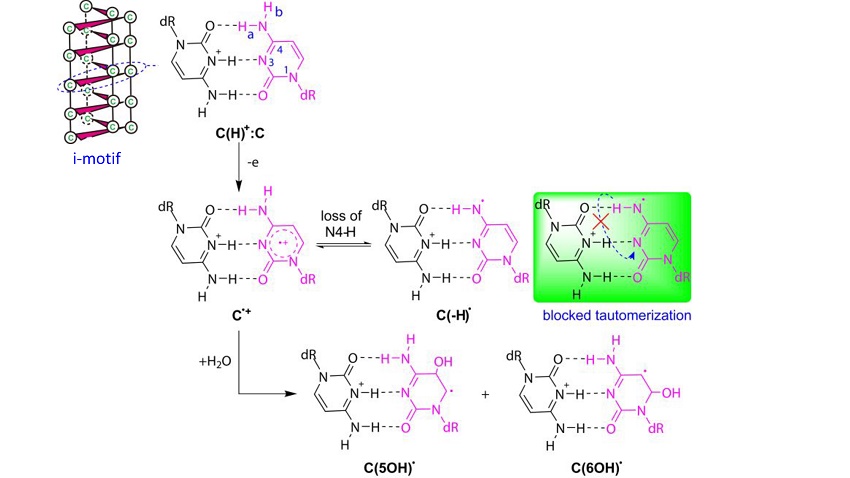Publication Highlight – Mechanism of DNA damage studied by transient absorption spectroscopy
Congratulations to our customer Prof. Hongmei Su at Beijing Normal University, for her recent publication in JACS.1
One of the lines of Prof. Su’s research work is the photochemistry of DNA and RNA damage. DNA damage can be caused by reactive species such as radicals or by radiation, and is related to cancer and degenerative diseases. Understanding the mechanisms of damage is the first step towards prevention.
In this publication Prof. Su’s team studied the one-electron oxidation of cytosine (C) bases in DNA. This oxidation takes place upon exposure to radiation and it can induce GC → AT transversions in DNA which result in genetic mutations. The one-electron oxidation product of cytosine, dC•+, is a highly reactive radical species that transforms into stable products through various pathways depending on its chemical environment. Here, the researchers have used an LP920 transient absorption spectrometer to study its multiple reaction mechanisms, by looking at the time evolution of the sample’s absorption. They studied both cytosine on its own and in a quadruplex structure known as i-motif DNA, which consists of 4 strands of cytosine bases grouped together. The results shed light on the oxidative damage of i-motif and how its structure affects its reactivity.
The radical cation dC•+ was generated by oxidation by SO4•–, which was produced by flash photolysis of Na2S2O8. The dC•+ radical cations may decay through several pathways: deprotonation and tautomerisation giving iminyl radicals, and hydration giving OH adduct radicals (Fig. 1). The researchers used different strategies to unravel the kinetics of each pathway. Following the decay of dC•+ absorbance at pH = 7.0 and pH = 3.0 gives the rates of deprotonation and hydration, respectively. dC•+ and dC(-H)• were differentiated by concentration-dependent studies. OH radical formation was discerned with experiments under N2 and O2, since O2 quenches OH adduct radicals effectively. Using these strategies, Su and co-workers obtained the kinetics of the full reaction by just following one wavelength, 415 nm, in the LP920 spectrometer.
Figure 1. Left: Reaction pathways of cytosine oxidation. Right: Transient absorption spectra for dC + Na2S2O8 after 355 nm photolysis, pH = 3.0 (a) and pH = 5.0 (b); 415 nm transient absorption kinetics at varying pH (c) and under different atmospheres (d). Data obtained with Edinburgh Instruments LP920 spectrometer. Adapted with permission from Reference 1. Copyright 2019 American Chemical Society.
In the case of i-motif, hydrogen bonding between C bases affects dramatically the kinetics and final products of the reaction. Experiments like the above with i-motif instead of single cytosine revealed that hydration is much more favoured in i-motif: bonding with the adjacent cytosine base makes dC•+ much more hydrophilic, and the tautomerisation step of C(-H)• is blocked due to hydrogen bonding (Fig. 2). These results indicate that hydrogen bonding plays a major role in the oxidative damage of DNA. Detailed information on the reaction mechanism can be obtained with a microsecond transient absorption instrument such as the LP920 or LP980 spectrometer.
Figure 2. Reaction pathways of i-motif oxidation. Adapted with permission from Reference 1. Copyright 2019 American Chemical Society
DNA Damage Complete Research Paper
For further information on this research into the mechanism of DNA damage simply download the full paper from JACS.
References
1. Y. Wang, et al. Degradation of Cytosine Radical Cations in 2′-Deoxycytidine and in i-Motif DNA: Hydrogen-Bonding Guided Pathways. J. Am. Chem. Soc. 141 (5), pp 1970 – 1979 (2019)
DNA Damage Research Instrumentation
If you are working in the field of DNA damage research, the LP980 Spectrometer is a premier research instrument providing unsurpassed measurement capabilities across an extensive range of chemical, physical and biological applications. To find out how it can be best used within your own research, please contact us.










